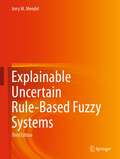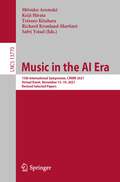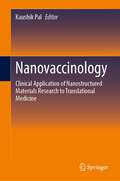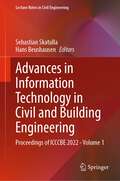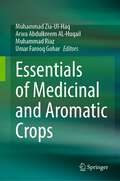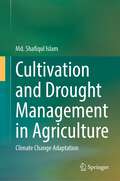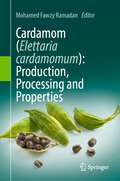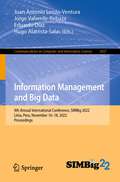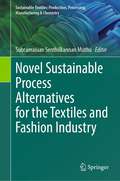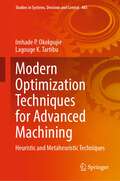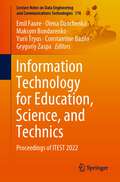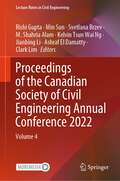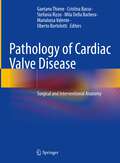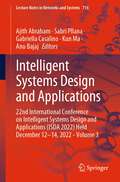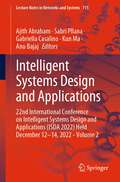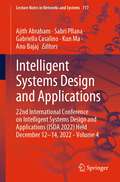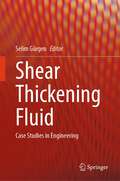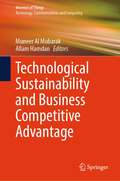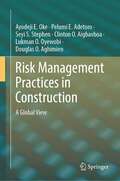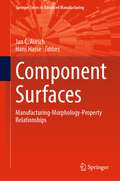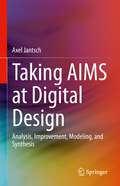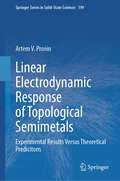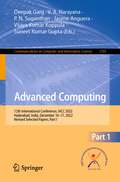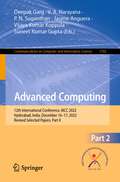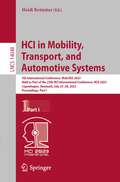- Table View
- List View
Explainable Uncertain Rule-Based Fuzzy Systems
by Jerry M. MendelThe third edition of this textbook presents a further updated approach to fuzzy sets and systems that can model uncertainty — i.e., “type-2” fuzzy sets and systems. The author demonstrates how to overcome the limitations of classical fuzzy sets and systems, enabling a wide range of applications, from time-series forecasting to knowledge mining to classification to control and to explainable AI (XAI). This latest edition again begins by introducing classical (type-1) fuzzy sets and systems, and then explains how they can be modified to handle uncertainty, leading to type-2 fuzzy sets and systems. New material is included about how to obtain fuzzy set word models that are needed for XAI, similarity of fuzzy sets, a quantitative methodology that lets one explain in a simple way why the different kinds of fuzzy systems have the potential for performance improvements over each other, and new parameterizations of membership functions that have the potential for achieving even greater performance for all kinds of fuzzy systems. For hands-on experience, the book provides information on accessing MATLAB, Java, and Python software to complement the content. The book features a full suite of classroom material.
Music in the AI Era: 15th International Symposium, CMMR 2021, Virtual Event, November 15–19, 2021, Revised Selected Papers (Lecture Notes in Computer Science #13770)
by Mitsuko Aramaki Keiji Hirata Tetsuro Kitahara Richard Kronland-Martinet Sølvi YstadThis book constitutes the refereed proceedings and revised selected papers from the 15th International Symposium on Music in the AI Era, CMMR 2021, which took place during November 15–19, 2021 as a virtual event. The 24 full papers included in this book were carefully reviewed and selected from 48 submissions. The papers are grouped in thematical sessions on Music technology in the IA era; Interactive systems for music; Music Information Retrieval and Modeling; and Music and Performance Analysis.
Nanovaccinology: Clinical Application of Nanostructured Materials Research to Translational Medicine
by Kaushik PalThis book provides an overview of the cumulative work on a driving force for innovation in medicine and modern healthcare, boosting advances in therapeutics, biosensors, vaccines, and clinical systems. The work presented shows how nanoparticles have been investigated as vaccine adjuvants because they possess chemical and structural properties that improve immunogenicity as well as the use of nanotechnology in the construction of immunization systems that has developed into the field of viral nanovaccinology. The volume highlights potential areas of research, innovation, and development of finished products for future commercialization and significant research exploration through nanoparticles that prove capable of surmounting most of the barriers like toxicity issues, clearance from biological system, DNA instability, and differences in expression systems. The contributing authors review the primary literature on principles, limitations, and recent breakthroughs in nanoparticle-based antigen delivery vehicles, their use in different diseases, the major bottlenecks, and related issues. Highlighting advances in nanoparticle engineering and the understanding of nanoparticle characteristics as well as critical legacy work dome in the field of nanobiotechnology, the book is ideal for a range of researchers and students in the pure and applied sciences devoted to nanomaterials, vaccinology, and translational medicine.
Advances in Information Technology in Civil and Building Engineering: Proceedings of ICCCBE 2022 - Volume 1 (Lecture Notes in Civil Engineering #357)
by Sebastian Skatulla Hans BeushausenThis book gathers the latest advances, innovations, and applications in the field of information technology in civil and building engineering, presented at the 19th International Conference on Computing in Civil and Building Engineering (ICCCBE), held in Cape Town, South Africa on October 26-28, 2022. It covers highly diverse topics such as BIM, construction information modeling, knowledge management, GIS, GPS, laser scanning, sensors, monitoring, VR/AR, computer-aided construction, product and process modeling, big data and IoT, cooperative design, mobile computing, simulation, structural health monitoring, computer-aided structural control and analysis, ICT in geotechnical engineering, computational mechanics, asset management, maintenance, urban planning, facility management, and smart cities. Written by leading researchers and engineers, and selected by means of a rigorous international peer-review process, the contributions highlight numerous exciting ideas that will spur novel research directions and foster multidisciplinary collaborations.
Essentials of Medicinal and Aromatic Crops
by Muhammad Zia-Ul-Haq Arwa Abdulkreem AL-Huqail Muhammad Riaz Umar Farooq GoharMedicinal and aromatic crops (MACs) are high-value crops since the natural products obtained from them are low-volume high-value commodities that have numerous applications in various sectors such as the food, beverage, food supplement, flavor and fragrance, perfumery and cosmetics, pharmaceutical and aromatherapy industries. In addition, the plant biomass is used in the production of teas and medical applications in traditional and also modern medicines. MACs are important mainly because they contain plant secondary metabolites such as essential oils, alkaloids, glygosides, saponins, tannins, vitamins and other bioactives. Plant secondary metabolites are differentiated from plant primary metabolites of photosynthesis and respiration since they are directly involved in growth and development of plants. Some MACs are used as spices and culinary herbs since they contain mainly essential oils, and are used as tonic to the digestive system, appetite modification and other systems and may facilitate nutrient uptake and utilization from various foods. A significant amount of MACs and their natural products have also demonstrated antimicrobial, antifungal and bactericidal activity and significant antioxidant capacity. In the past, MACs and their natural products have been used as a source for various medicines, in food and beverage production and in aroma products. Essentials of Medicinal and Aromatic Crops summarizes the current knowledge on medicinal and aromatic crops, including the agronomical practices of important MACs and their products, their beneficial effects and utilization of MAP and their products. The chapters provide a comprehensive guide to the most important and used medicinal and aromatic crops and their use in functional foods, nutraceuticals and as bioactives against various ailments, providing researchers, teachers, chemists, food scientists, agronomists and agroecologists in academia, industry and government a fully up to date singular source on this important topic.
Cultivation and Drought Management in Agriculture: Climate Change Adaptation
by Md. Shafiqul IslamThis book represents the background of the Barind Tract of Bangladesh with the proximity of drought information, conceptual and logic of the books, history, definition and perception on drought and climate scenario and how people understand underlying causes, impacts and consequences of drought in agriculture, environment, human health and society. It also states the trend and severity of drought of Barind Tract. This book gives the local response to cope, mitigation and adaptation to agricultural drought. The book also addresses the gender response in the hardship of drought in the rural areas. It also elicits the local and indigenous methods of drought prediction and sustainable cultivation and management of drought in agriculture.
Cardamom (Elettaria cardamomum): Production, Processing and Properties
by Mohamed Fawzy RamadanCardamom [Elettaria cardamomum (L.) Maton is recognized for its unique taste and aroma. As the third most expensive spice after saffron and vanilla, Cardamom has been used as a spice and flavoring ingredient in food and is rich in bioactive constituents including minerals, carbohydrates, proteins, lipids, essential oils, terpenoids, flavonoids and carotenoids. Cardamom essential oil (CEO) and other bioactive compounds accumulated in cardamom capsules contribute to their characteristic aroma and utility as a novel food and nutraceutical. CEO from capsules possesses monoterpene constituents such as α-terpineol, 1,8-cineole, α-pinene, linalyl acetate, linalool, and nerolidol as well as the ester of α-terpinyl acetate. Flavonoids, anthocyanins, terpenoids, alkaloids, and other cardamom phenolics have shown high MIC values against Campylobacter species and reduced Bacillus subtilis spore. CEO loses its flavor rapidly upon storing under a normal environment. The change in the aroma or flavor could also cause changes in the constituents of its phytochemicals.Cardamom (Elettaria cardamomum): Production, Processing & Properties aims to create a multidisciplinary forum of discussion on E. cardamomum, emphasizing its botany, ethnobotanical, cultivation, horticultural practices, post-harvest, marketability, phytochemistry, extraction protocols, biochemistry, nutritional value, functionality, ethnomedicinal applications and and processing specifics. The book discusses the botanical distribution, phytochemical constituents, food applications and biological activities of cardamom capsule extracts and essential oil. Also, the text discusses the potential applications of E. cardamomum in food, cosmetics and pharmaceutical products. This book is the first of its kind, a full research work dedicated specifically to cardamom applications and benefits that will be of value for researchers from multiple fields.
Information Management and Big Data: 9th Annual International Conference, SIMBig 2022, Lima, Peru, November 16–18, 2022, Proceedings (Communications in Computer and Information Science #1837)
by Juan Antonio Lossio-Ventura Jorge Valverde-Rebaza Eduardo Díaz Hugo Alatrista-SalasThis book constitutes the refereed proceedings of the 9th Annual International Conference on Information Management and Big Data, SIMBig 2022, held in Lima, Peru, during November 16–18, 2022.The 18 full papers and 1 short paper included in this book were carefully reviewed and selected from 50 submissions. The volume presented novel methods for the analysis and management of large data, in fields like Artificial Intelligence (AI), Data Science, Machine Learning, Natural Language Processing, Semantic Web, Data-driven Software Engineering, Health Informatics.
Novel Sustainable Process Alternatives for the Textiles and Fashion Industry (Sustainable Textiles: Production, Processing, Manufacturing & Chemistry)
by Subramanian Senthilkannan MuthuEnvironmental impacts created by the textiles and fashion sector are well known and acknowledged by various stakeholders involved in the entire supply chain. The lifecycle of textile products creates various impacts to the environment and any attempts to alleviate them are highly welcomed. The whole sector is keen to investigate novel sustainable alternatives in terms of raw materials, processes, approaches to make the entire textiles and fashion sector more sustainable. This broad category of novel sustainable alternatives can be split into three subtopics: novel raw material alternatives, novel process alternative and novel alternative approaches. This volume provides cases describing novel sustainable process alternatives for the textiles and fashion industry.
Modern Optimization Techniques for Advanced Machining: Heuristic and Metaheuristic Techniques (Studies in Systems, Decision and Control #485)
by Imhade P. Okokpujie Lagouge K. TartibuAdvanced manufacturing via computer numerical machining is the art of producing mechanical components employed in aerospace, automobile, and industrial applications where a high level of accuracy is needed. This book focuses on the nano-machining of aluminum alloy and its optimization. The application of aluminum alloy in the manufacturing industry has increased tremendously due to its lightweight to high strength ratio and high-level resistance to corrosion. However, aluminum alloy has some challenges during the machining and manufacturing stage in order to solve real-life manufacturing challenges in advanced machining operation for sustainable production processes. Therefore, it is a need for the implementation of a general algebraic modeling system (GAMS) and other metaheuristic techniques for problem solving and to effectively develop mathematical models for high accuracy prediction and optimization under nano-lubrication machining conditions. This book discusses majorly on the major three responses in machining such as surface roughness, cutting force, and material removal rate, which will give an excellent guide to undergraduate and postgraduate students, senior research fellows in academia, operational, and strategic staff in manufacturing industries.
Information Technology for Education, Science, and Technics: Proceedings of ITEST 2022 (Lecture Notes on Data Engineering and Communications Technologies #178)
by Emil Faure Olena Danchenko Maksym Bondarenko Yurii Tryus Constantine Bazilo Grygoriy ZaspaThis book gathers selected high-quality full-text papers presented at the VI International Scientific and Practical Conference on Information Technology for Education, Science and Technics (ITEST 2022). The book deals with issues related to mathematical and computer modeling of physical, chemical, and economic processes, with information security, as well as the use of information and communication technology in scientific research, automation of technological processes, and management of complex systems. In this book, the authors explore various aspects of the development of information technology and systems and its application in education, science, engineering, economics, and management. A part of the book is devoted to the application of information and communication technology in higher education, in particular, the creation and implementation of scientific and educational resources in higher education institutions as part of the process of education digital transformation.
Proceedings of the Canadian Society of Civil Engineering Annual Conference 2022: Volume 1 (Lecture Notes In Civil Engineering Ser. #363)
by Rishi Gupta Min Sun Svetlana Brzev M. Shahria Alam Kelvin Tsun Wai Ng Jianbing Li Ashraf El Damatty Clark LimPathology of Cardiac Valve Disease: Surgical and Interventional Anatomy
by Gaetano Thiene Cristina Basso Stefania Rizzo Mila Della Barbera Marialuisa Valente Uberto BortolottiCardiac valve diseases are a major cause of morbidity and mortality around the globe. In third world countries, inflammatory rheumatic valve disease in the young represents an endemic calamity, while in Western countries, degenerative valve diseases like senile calcific aortic stenosis and mitral valve prolapse as a result of mucoid degeneration with incompetence are major causes of death in adults/the elderly. Since the 1960s, surgical valve replacement has been the only treatment option, requiring sternotomy, cardiopulmonary bypass and cardiac arrest. Permanent anticoagulation for mechanical valves and the limited durability of biological valves constituted significant drawbacks; moreover, these surgeries often requires surgical replacement. The cardiac registry at the University of Padua, Italy, has gathered more than twelve hundred cases of failed prosthetic valves, offering a unique resource for teaching and research. Conservative valve repair using minimally invasive technique showed that replacement of the native valve with sternotomy can be spared. Moreover, in the last decade venous or arterial approaches like TAVI were developed. Presenting the essential surgical and interventional anatomy and pathology in detail, this book offers a valuable tool for cardiologists, cardiac surgeons and pathologists, as well as people in training and scientists working in the field of medical devices and biological compatibility.
Intelligent Systems Design and Applications: 22nd International Conference on Intelligent Systems Design and Applications (ISDA 2022) Held December 12-14, 2022 - Volume 3 (Lecture Notes in Networks and Systems #716)
by Ajith Abraham Sabri Pllana Gabriella Casalino Kun Ma Anu BajajThis book highlights recent research on intelligent systems and nature-inspired computing. It presents 223 selected papers from the 22nd International Conference on Intelligent Systems Design and Applications (ISDA 2022), which was held online. The ISDA is a premier conference in the field of computational intelligence, and the latest installment brought together researchers, engineers, and practitioners whose work involves intelligent systems and their applications in industry. Including contributions by authors from 65 countries, the book offers a valuable reference guide for all researchers, students, and practitioners in the fields of computer science and engineering.
Intelligent Systems Design and Applications: 22nd International Conference on Intelligent Systems Design and Applications (ISDA 2022) Held December 12-14, 2022 - Volume 2 (Lecture Notes in Networks and Systems #715)
by Ajith Abraham Sabri Pllana Gabriella Casalino Kun Ma Anu BajajThis book highlights recent research on intelligent systems and nature-inspired computing. It presents 223 selected papers from the 22nd International Conference on Intelligent Systems Design and Applications (ISDA 2022), which was held online. The ISDA is a premier conference in the field of computational intelligence, and the latest installment brought together researchers, engineers, and practitioners whose work involves intelligent systems and their applications in industry. Including contributions by authors from 65 countries, the book offers a valuable reference guide for all researchers, students, and practitioners in the fields of computer science and engineering.
Intelligent Systems Design and Applications: 22nd International Conference on Intelligent Systems Design and Applications (ISDA 2022) Held December 12-14, 2022 - Volume 4 (Lecture Notes in Networks and Systems #717)
by Ajith Abraham Sabri Pllana Gabriella Casalino Kun Ma Anu BajajThis book highlights recent research on intelligent systems and nature-inspired computing. It presents 223 selected papers from the 22nd International Conference on Intelligent Systems Design and Applications (ISDA 2022), which was held online. The ISDA is a premier conference in the field of computational intelligence, and the latest installment brought together researchers, engineers, and practitioners whose work involves intelligent systems and their applications in industry. Including contributions by authors from 65 countries, the book offers a valuable reference guide for all researchers, students, and practitioners in the fields of computer science and engineering.
Shear Thickening Fluid: Case Studies in Engineering
by Selim GürgenShear Thickening Fluid: Case Studies in Engineering provides a set of case studies and research data on the cutting-edge technology of shear thickening fluid (STF) to assist readers with understanding the adaptive behavior of STF in different engineering applications. Various engineering designs are adapted by including STF to take advantage of this smart material in the areas of protective structures, energy-absorbing systems, vibration-damping devices, and surface finishing operations. A companion volume to the book Shear Thickening Fluid: Theory and Applications, this volume will be a valuable reference for practicing engineers, researchers, and scientists working in advanced materials, smart structures, and intelligent engineering applications.
Technological Sustainability and Business Competitive Advantage (Internet of Things)
by Muneer Al Mubarak Allam HamdanThis book discusses advanced technological solutions in Industry 5.0 that can be used for business competitive advantage and sustainability. The book presents tools that can help reduce time and make use of data in an efficient way while using resources efficiently and sustainably. The book aims to highlight technological sustainability through promoting innovations, improving social development, and providing green products that benefit the society. The authors discuss the recent technological advancements such as Artificial Intelligence (AI), Internet of Things (IoT), Financial Technology (FinTech), Big Data, and Blockchain. They also discuss the benefits of incorporating such technologies in areas such as green supply chain, storage technology, Internet banking, and nanotechnology. The target audience of this book includes all interested individuals and institutions in the fields of engineering, business, technology, and public services. The book provides insights and solutions to many issues and creates opportunities for further sustainability.
Risk Management Practices in Construction: A Global View
by Ayodeji E. Oke Pelumi E. Adetoro Seyi S. Stephen Clinton O. Aigbavboa Lukman O. Oyewobi Douglas O. AghimienThis volume describes risk management practices in the construction industry in selected countries, with an emphasis on developing countries and how these countries can learn from the practices in more developed ones. Risk management in the construction industry can be difficult to understand due to the various complex procedures that are involved and to the unique concerns and contexts associated with each project. The industry has been a key contributor to the economic and social development of many countries of the world and is increasingly incorporating sustainability into its practices. However it is plagued by various risks that can affect the quality, cost, time and overall sustainability of projects. Therefore, there is need to effectively manage risk in order to ensure timely completion of construction projects in good quality and within budget, which in turn results in more efficient and often more sustainable practices. The book is divided into four parts. The first section features a primer on risk management practices as they pertain to the construction industry. The second part dives in to describe risk management in selected developing countries, including Malaysia, Qatar, Saudi-Arabia, South Africa, Sri-Lanka and Tanzania, as well as the city of Hong Kong. The third section describes the construction risk management practices of a selection of more developed countries with known risk management institutes and established practices of risk management. These countries include Australia, Canada, Sweden and United States of America. The fourth part offers a general overview of the definition, concepts and process of risk management based on reviewed literature. It also discusses the benefits of effective risk management to clients and to project teams, especially from the perspective of ensuring sustainability. This last section also summarizes the risk management practices in both developing and developed countries for the purpose of improving the practices in the former by learning from the latter.
Component Surfaces: Manufacturing-Morphology-Property Relationships (Springer Series in Advanced Manufacturing)
by Jan C. Aurich Hans HasseThis book sheds new light on component surfaces and the scientific fundamentals of their creation, characterization, and application. The book also provides a new interdisciplinary perspective on the topic, studying component surfaces with a multiscale approach and linking fundamental and applied research. The book builds on the success of the coordinated research project funded by Deutsche Forschungsgemeinschaft (DFG) from 2011 – 2023: the CollaborativeResearch Center CRC 926 “Microscale Morphology of Component Surfaces (MI-COS)”, in which, over the years, 100+ researchers have co-operated at the University of Kaiserslautern, Germany, and affiliated institutes, yielding 500+ scientific papers in journals from different fields of science and engineering. Divided into 2 main parts, the book starts with an introduction to the concept of Manufacturing-Morphology-Property (MMP) Relationships and dives into the fundamentals and technologies, including topics such as the geometrical, microstructural, and chemical characterization, indentation, and scratching on the nanoscale, micro milling and micro grinding, cryogenic machining, cold spraying, and additive manufacturing. In the first part, readers discover more about the interactions between particles and surfaces, the interrelationship of manufacturing, surface morphology and properties of titanium, the influence of manufacturing and load conditions on the phase transformation and fatigue of austenitic stainless steels, and the influence of surface morphology on fatigue and tribological behavior of Transformation-Induced-Plasticity (TRIP)/Twinning-Induced Plasticity (TWIP) Steels. The second part of this book is devoted to the applications of component surfaces, covering topics like the manufacturing of areal material measures, MMP relationships for rotating shaft sealing systems, the influence of the surface morphology on rolling bearing life under mixed lubrication, MMP relationships for chain joints, and MMP for biofilms. Scientists and engineers who deal with the influence of surfaces on macroscopic properties of components and who are interested in designing and manufacturing these surfaces to obtain desired component properties will understand the appeal of this work. Given its interdisciplinary breadth, the book also appeals to scholars and professionals in the fields of mechanical engineering, process engineering, and physics.
Taking AIMS at Digital Design: Analysis, Improvement, Modeling, and Synthesis
by Axel JantschThis is an introductory textbook for courses in Synchronous Digital Design that enables students to develop useful intuitions for all of the key concepts of digital design. The author focuses this tutorial on the design flow, which is introduced as an iterative cycle of Analysis, Improvement, Modeling, and Synthesis. All the basic elements of digital design are covered, starting with the CMOS transistor to provide an abstraction upon which everything else is built. The other main foundational concepts introduced are clocked synchronous register-transfer level design, datapath, finite state machines and communication between clock domains.
Linear Electrodynamic Response of Topological Semimetals: Experimental Results Versus Theoretical Predicitons (Springer Series in Solid-State Sciences #199)
by Artem V. ProninThis book provides a model description for the electromagnetic response of topological nodal semimetals and summarizes recent experimental findings in these systems. Specifically, it discusses various types of topological semimetals – Dirac, Weyl, nodal-line, triple-point, and multifold semimetals – and provides description for the characteristic features of the linear electrodynamic response for all these types of materials.Topological semimetals possess peculiar bulk electronic band structure, which leads to unusual electrodynamic response. For example, the low-energy inter-band optical conductivity of nodal semimetals is supposed to demonstrate power-law frequency dependence and the intra- and inter-band contributions to the conductivity are often mixed. Further, the magneto-optical response is also unusual, because of the non-equidistant spacing between the Landau levels. Finally, in semimetals with chiral electronic bands, e.g. in Weyl semimetals, the simultaneous application of parallel magnetic and electric fields leads to the chiral anomaly, i.e. to a misbalance between the electrons with diffident chiralities. This misbalance affects the electrodynamics properties of the material and can be detected optically. All these points are addressed here in detail.The book is written for a wide audience of physicists, working in the field of topological condensed matter physics. It gives a pedagogical introduction enabling graduate students and non-experts to familiarize themselves with the subject.
Advanced Computing: 12th International Conference, IACC 2022, Hyderabad, India, December 16–17, 2022, Revised Selected Papers, Part I (Communications in Computer and Information Science #1781)
by Deepak Garg V. A. Narayana P. N. Suganthan Jaume Anguera Vijaya Kumar Koppula Suneet Kumar GuptaThis two-volume set constitutes reviewed and selected papers from the 12th International Advanced Computing Conference, IACC 2022, held in Hyderabad, India, in December 2022.The 72 full papers and 6 short papers presented in the volume were thorougly reviewed and selected from 415 submissions. The papers are organized in the following topical sections: AI in industrial applications; application of AI for disease classification and trend analysis; design of agricultural applications using AI; disease classification using CNN; innovations in AI; system security and communication using AI; use of AI in human psychology; use of AI in music and video industries.
Advanced Computing: 12th International Conference, IACC 2022, Hyderabad, India, December 16–17, 2022, Revised Selected Papers, Part II (Communications in Computer and Information Science #1782)
by Deepak Garg V. A. Narayana P. N. Suganthan Jaume Anguera Vijaya Kumar Koppula Suneet Kumar GuptaThis two-volume set constitutes reviewed and selected papers from the 12th International Advanced Computing Conference, IACC 2022, held in Hyderabad, India, in December 2022.The 72 full papers and 6 short papers presented in the volume were thorougly reviewed and selected from 415 submissions. The papers are organized in the following topical sections: AI in industrial applications; application of AI for disease classification and trend analysis; design of agricultural applications using AI; disease classification using CNN; innovations in AI; system security and communication using AI; use of AI in human psychology; use of AI in music and video industries.
HCI in Mobility, Transport, and Automotive Systems: 5th International Conference, MobiTAS 2023, Held as Part of the 25th HCI International Conference, HCII 2023, Copenhagen, Denmark, July 23–28, 2023, Proceedings, Part I (Lecture Notes in Computer Science #14048)
by Heidi KrömkerThis book constitutes the refereed proceedings of the 5th International Conference on HCI in Mobility, Transport, and Automotive Systems, MobiTAS 2023, held as part of the 25th International Conference, HCI International 2023, held in Copenhagen, Denmark, in July 2023. The total of 1578 papers and 396 posters included in the HCII 2022 proceedings was carefully reviewed and selected from 7472 submissions. The MobiTAS 2023 proceedings were organized in the following topical sections: Part I: Autonomous and Assisted Driving; Cooperative and Intelligent Transport Systems; Urban Mobility; and Sustainable Mobility. Part II: Driver Behavior and Performance; Designing Driver and Passenger User Experience; and Accessibility and Inclusive Mobility.
